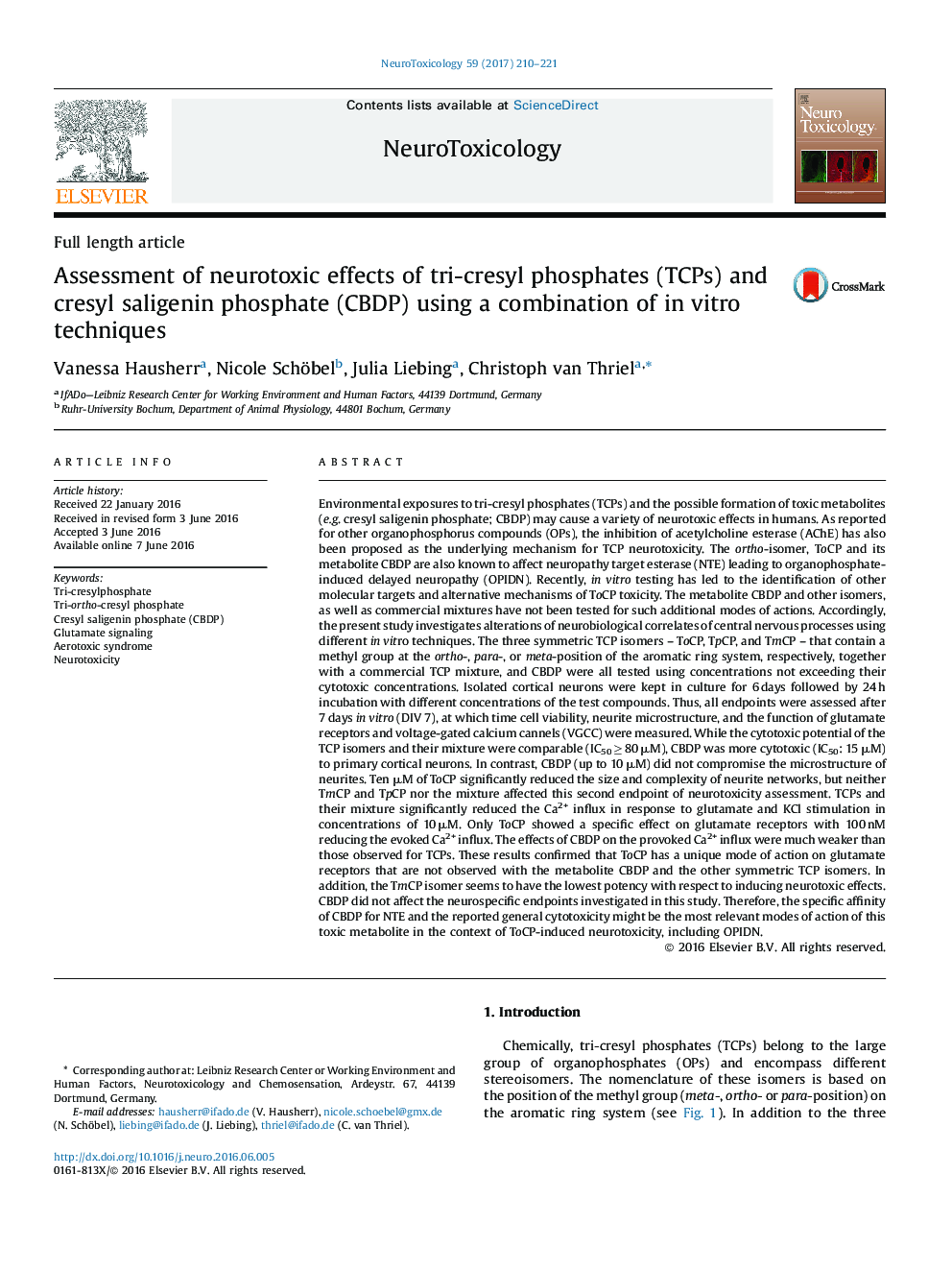| Article ID | Journal | Published Year | Pages | File Type |
|---|---|---|---|---|
| 5560959 | NeuroToxicology | 2017 | 12 Pages |
â¢Tri-cresyl phosphates induce structural and functional neurotoxicity in primary neurons in vitro.â¢Cresyl saligenin phosphate (CBDP) was more cytotoxic but less neurotoxic as indicated by no or weak effects on in vitro endpoints.â¢Impairment of glutamate signaling was the most sensitive endpoint of the selected endpoints.â¢ToCP is the most potent TCP isomer with respect to structural and functional neurotoxicity in vitro.
Environmental exposures to tri-cresyl phosphates (TCPs) and the possible formation of toxic metabolites (e.g. cresyl saligenin phosphate; CBDP) may cause a variety of neurotoxic effects in humans. As reported for other organophosphorus compounds (OPs), the inhibition of acetylcholine esterase (AChE) has also been proposed as the underlying mechanism for TCP neurotoxicity. The ortho-isomer, ToCP and its metabolite CBDP are also known to affect neuropathy target esterase (NTE) leading to organophosphate-induced delayed neuropathy (OPIDN). Recently, in vitro testing has led to the identification of other molecular targets and alternative mechanisms of ToCP toxicity. The metabolite CBDP and other isomers, as well as commercial mixtures have not been tested for such additional modes of actions. Accordingly, the present study investigates alterations of neurobiological correlates of central nervous processes using different in vitro techniques. The three symmetric TCP isomers - ToCP, TpCP, and TmCP - that contain a methyl group at the ortho-, para-, or meta-position of the aromatic ring system, respectively, together with a commercial TCP mixture, and CBDP were all tested using concentrations not exceeding their cytotoxic concentrations. Isolated cortical neurons were kept in culture for 6 days followed by 24 h incubation with different concentrations of the test compounds. Thus, all endpoints were assessed after 7 days in vitro (DIV 7), at which time cell viability, neurite microstructure, and the function of glutamate receptors and voltage-gated calcium cannels (VGCC) were measured. While the cytotoxic potential of the TCP isomers and their mixture were comparable (IC50 â¥Â 80 μM), CBDP was more cytotoxic (IC50: 15 μM) to primary cortical neurons. In contrast, CBDP (up to 10 μM) did not compromise the microstructure of neurites. Ten μM of ToCP significantly reduced the size and complexity of neurite networks, but neither TmCP and TpCP nor the mixture affected this second endpoint of neurotoxicity assessment. TCPs and their mixture significantly reduced the Ca2+ influx in response to glutamate and KCl stimulation in concentrations of 10 μM. Only ToCP showed a specific effect on glutamate receptors with 100 nM reducing the evoked Ca2+ influx. The effects of CBDP on the provoked Ca2+ influx were much weaker than those observed for TCPs. These results confirmed that ToCP has a unique mode of action on glutamate receptors that are not observed with the metabolite CBDP and the other symmetric TCP isomers. In addition, the TmCP isomer seems to have the lowest potency with respect to inducing neurotoxic effects. CBDP did not affect the neurospecific endpoints investigated in this study. Therefore, the specific affinity of CBDP for NTE and the reported general cytotoxicity might be the most relevant modes of action of this toxic metabolite in the context of ToCP-induced neurotoxicity, including OPIDN.
